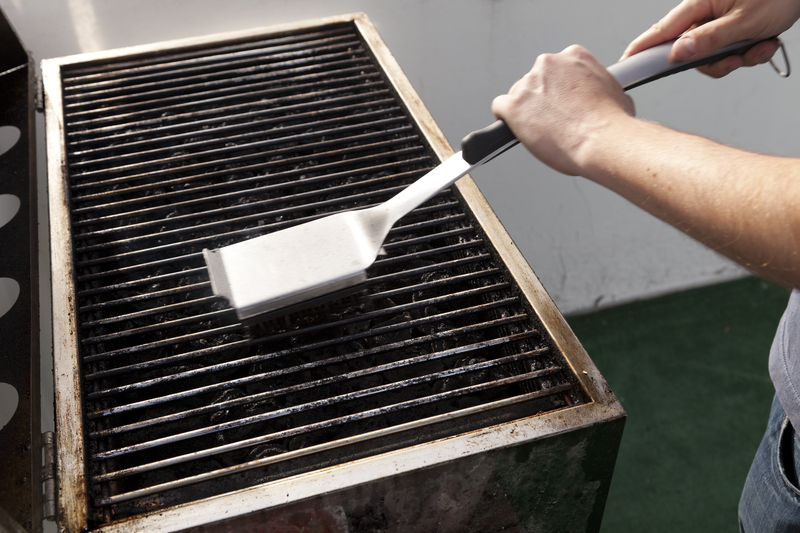A Comprehensive Approach to Mould-Free Window Sills
Posted on 27/06/2025
A Comprehensive Approach to Mould-Free Window Sills
Maintaining clean, mould-free window sills isn't simply about aesthetics; it's crucial for your home's air quality and structural longevity. Unsightly and potentially hazardous, mould thrives in damp environments, making window sills a frequent target. In this detailed guide, we explore how to keep your window sills free from mould, identify risk factors, discuss effective removal techniques, and introduce ongoing maintenance strategies for lasting protection.
Understanding the Risks of Mould on Window Sills
Before delving into prevention and remediation, it's important to understand why window sills are particularly susceptible to mould growth. Mould spores, omnipresent in the atmosphere, only need three things to flourish:
- Moisture
- Warmth
- Organic material (such as dust, dirt, or wooden window sills)
Mould spores find these conditions on window sills, especially in rooms with high humidity such as kitchens, bathrooms, and basements. This makes maintaining mould-proof window sills a priority for modern homeowners.

The Health Implications of Mould in Your Home
Exposure to indoor mould can lead to a variety of health issues, particularly for sensitive groups such as children, the elderly, and those with respiratory conditions. Some common symptoms include:
- Allergic reactions (sneezing, runny nose, skin rash)
- Asthma attacks or difficulty breathing
- Nasal congestion and sinus problems
- Headaches and fatigue
For these reasons, keeping window sills free from mould growth is more than just a housekeeping task--it's a health imperative.
Identifying the Signs of Mould on Window Sills
To achieve mould-free window ledges, early detection is key. Common signs include:
- Black, green, or white spots on the window sill or caulking
- A musty or damp odour around the window area
- Visible condensation on glass panes or sills, especially after rain or in the morning
- Peeling paint or wallpaper near the window frame
It's essential to inspect your window sills regularly for the above indicators, particularly during rainy seasons or in homes without adequate ventilation.
Causes of Mould Growth on Window Sills
1. Condensation Accumulation
Condensation is the number one cause of mould formation on windowsills. Warm, moist air inside the home meets the cool glass or frame, resulting in water droplets that settle onto the sill and encourage mould to flourish.
2. Poor Ventilation
Insufficient airflow, especially in tightly sealed modern buildings, can trap moisture around windows. Without regular air exchange, dampness persists, giving mould the constant moisture it requires.
3. Leaking Windows or Poor Insulation
Drips from poorly sealed window frames or gaps in insulation can introduce new sources of water. Left unchecked, these leaks saturate wooden or painted surfaces, escalating the mould risk.
4. Dust and Organic Debris Build-up
Window sills often gather dust, dirt, pollen, and even tiny insects. These organic materials serve as food sources for mould. Regular cleaning of window ledges is crucial not just for appearance but also for mould prevention.
A Step-by-Step Guide to Removing Mould from Window Sills
If mould has already formed, immediate action is necessary to restore mould-free windowsills. Here's how:
Step 1: Gather Supplies
- Gloves and a mask (to avoid inhaling spores)
- Protective eye wear
- Disposable cloths or paper towels
- A bucket of warm water
- Mild detergent or white vinegar
- Baking soda (optional, for stubborn stains)
- Old toothbrush or a soft-bristled brush
- Spray bottle
Step 2: Protect Surrounding Areas
Cover adjacent furniture, flooring, and walls to prevent the spread of spores and cleaning agents. Open windows slightly for ventilation if weather permits.
Step 3: Remove Surface Mould
- Spray the affected area with a solution of warm water and white vinegar (1:1 ratio). Vinegar is a natural fungicide and safe for most surfaces.
- Let it sit for 5-10 minutes to penetrate the spores.
- Gently scrub with a brush to loosen the mould, wiping away excess with disposable cloths.
- For persistent stains, apply a paste of baking soda and water, allow it to sit, then scrub and rinse.
Step 4: Rinse and Dry Thoroughly
Use a clean, damp cloth to wipe away any cleaning residue. Dry the area completely with a fresh towel, as residual moisture can encourage regrowth.
Step 5: Dispose and Clean Up Carefully
- Bag all used paper towels, wipes, and gloves, and remove them from your home immediately.
- Wash reusable cleaning tools in hot, soapy water.
- Wash your hands thoroughly after the cleaning process.
Ongoing Prevention: How to Keep Your Window Sills Mould-Free
A one-time cleaning is only part of a lasting, comprehensive defence against window sill mould. Adopt these habits and strategies for ongoing protection:
1. Control Humidity Levels
- *Use dehumidifiers*, especially in problem spaces like basements and bathrooms, to keep relative humidity under 50%.
- Install vent fans or open windows for a few minutes daily to circulate fresh air.
2. Regular Cleaning and Inspection
- Wipe down windowsills and frames weekly with a mild cleaning solution to remove dust and organic debris.
- Inspect foam seals, caulking, and weatherstripping for gaps where water could seep.
3. Improve Window Insulation
- Ensure windows are double-glazed or use insulating film to minimize temperature differences that cause condensation.
- Upgrade old or leaky window frames with modern, energy-efficient alternatives.
4. Use Anti-Mould Paint and Finishes
If you are renovating or replacing window sills, consider applying mould-resistant primer and paint. These finishes contain antimicrobial agents that inhibit mould regrowth and make cleaning easier.
5. Address Leaks Promptly
Check the exterior seals and caulking periodically. Repair any visible leaks or cracks immediately to prevent water infiltration.
6. Avoid Overwatering Indoor Plants Near Windows
- *Excess water* from plant pots can seep into sills, creating damp microclimates ideal for mould.
- Place a tray beneath pots and monitor for leaks.
Professional Services for Persistent Window Sill Mould
Sometimes, DIY efforts are not enough, particularly with longstanding or extensive infestations. In such cases, professional assessment and remediation may be required for permanent mould removal from window sills. Experts can:
- Conduct moisture mapping to identify hidden leaks or water sources
- Test for toxic varieties of mould such as Stachybotrys (black mould)
- Safely remove large areas of contamination
- Recommend structural repairs to prevent recurrence
While professional services represent an upfront investment, they safeguard your home's value and your family's health.
Eco-Friendly Cleaning Alternatives for Mould-Free Windowsills
In pursuing a mould-free environment for window sills, you might prefer to avoid harsh chemicals. Here are some reliable, planet-friendly alternatives:
- Tea Tree Oil: Mix 1 teaspoon of tea tree oil with 1 cup of water in a spray bottle. Mist, let sit, and wipe. Tea tree oil is naturally antifungal.
- Hydrogen Peroxide: Spray 3% hydrogen peroxide solution directly on the mould, let it bubble for 10 minutes, then scrub and rinse.
- Baking Soda: A gentle abrasive--mix with water, scrub, and rinse to eliminate odours and spores.
Note: Always test any cleaning solution on a small, inconspicuous area first to ensure it doesn't damage surfaces.
Choosing the Best Window Sill Materials for Mould Resistance
Selecting optimal materials can make a dramatic difference in mould prevention for window sills. Some options include:
- uPVC (Unplasticized Polyvinyl Chloride): Highly resistant to moisture and does not absorb water--ideal for damp environments.
- Composite Materials: Engineered stone or resin-based products can mimic traditional sills but are less porous and easier to clean.
- Sealed Natural Stone: Marble and granite, if properly sealed, can be more mould-resistant but require maintenance.
*Wooden sills* should be painted with multiple layers of waterproof sealant, and regularly checked for chips or cracks.

Frequently Asked Questions: Mould-Free Window Sills
How Often Should I Clean My Window Sills to Prevent Mould?
Ideally, clean window sills at least once a week, or more frequently in humid months or after periods of heavy rain.
Are There Any Permanent Solutions for Window Sill Mould?
Permanent solutions involve rectifying moisture and ventilation issues and, if possible, replacing old sills with mould-resistant materials.
Can Mould on Window Sills Spread to Other Areas?
Yes, mould spores are easily airborne and can colonize other damp surfaces if not contained and removed promptly.
Is Vinegar Safe for All Window Sill Materials?
Vinegar is safe for most materials except some natural stones (like marble), which can etch. Always test in an inconspicuous area first.
When Should I Call a Professional?
If the affected area is larger than one square meter, recurs after cleaning, or you notice health symptoms, consult a mould remediation specialist.
Conclusion: Building a Lasting Defence Against Mouldy Window Sills
Creating mould-resistant window sills is a multifaceted process, blending regular cleaning, material choice, adequate ventilation, and prompt repairs. By adopting both preventive measures and effective cleaning techniques, you can ensure your window sills remain clean, safe, and durable for years.
A comprehensive approach to mould-free window sills is not just about removing the visible threat--it's about solving the underlying causes and committing to an ongoing regimen of care. Protect your investment, your health, and the beauty of your home by making mould prevention a priority.
Ready to start your journey to mould-free window sills? Implement these tips today and enjoy a fresher, healthier living space all year round!





